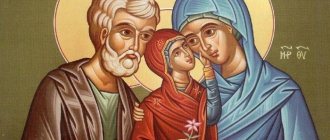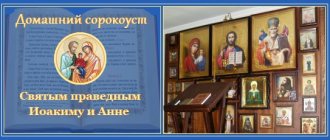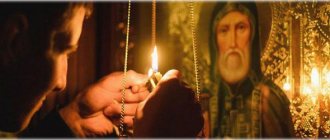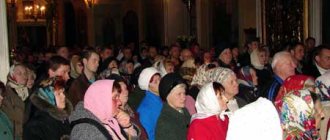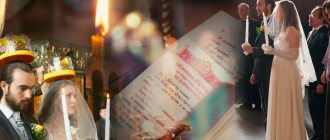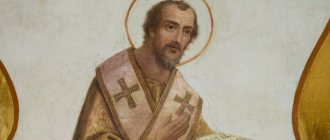Holy Righteous Joachim and Anna. Life
Saint Joachim was the husband of Saint Anne, the father of the Mother of God. Hagiography gives Joachim the following origin: “His genealogy is as follows: David’s son Nathan gave birth to a son, Levi, Levi gave birth to Melchia and Panfir, Panfir gave birth to Varpafir, and Varpafir gave birth to Joachim, the father of the Mother of God.” Joachim lived in Nazareth. He married Anna, the youngest daughter of the priest Matthan from the high priestly family of Aaron. According to her father, she was from the tribe of Levi, and according to her mother, she was from the tribe of Judah. The conception and birth of the Mother of God is known from the apocryphal Proto-Gospel of James (2nd century). According to this apocrypha, Joachim and Anna did not have children for a long time. When the high priest denied Joachim the right to make a sacrifice to God, since he “did not create offspring for Israel,” he withdrew into the desert, and his wife remained at home alone. At this time, they both had a vision of an angel who announced: “The Lord has heeded your prayer, you will conceive and give birth, and your offspring will be talked about all over the world.”
After this gospel, Joachim and Anna met at the Golden Gate of Jerusalem. And so Joachim approached with his flocks, and Anna, who was standing at the gate, saw Joachim coming, and, running up, hugged him, and said: “I know now that the Lord has blessed me: being a widow, I am no longer a widow, being barren, I Now I’ll conceive!” And Joachim found peace in his home that day. (Proto-Gospel of James (4:7-8)). After this, Joachim came to the Jerusalem temple, saying: “If the Lord has mercy on me, then the priest’s golden plate will show me.” And Joachim brought his gifts, and looked intently at the plate, approaching the altar of the Lord, and did not see sin in himself. (Proto-Gospel of James (5:1-2)). Anna conceived, “the months allotted to her passed, and Anna gave birth in the ninth month.” The date of conception, December 9, was set on the basis that it would be 9 months from the date of the Nativity of the Virgin Mary (September 8).
The four canonical Gospels do not mention the name of Mary's mother. Anna appears only in the apocryphal tradition, in particular in the Proto-Gospel of James, as well as in the Gospel of Pseudo-Matthew and the Golden Legend. The tradition was also influenced by the “Word on the Nativity of the Blessed Virgin Mary” by Andrew of Crete (VII-VIII centuries). According to Jewish custom, on the 15th day after the birth of the baby, she was given the name indicated by the angel of God - Mary. The parents, out of gratitude to the Lord, promised to send the child to the Temple. Mary was brought into the Temple at the age of three. Joachim and Anna placed their daughter on the first step, and, to everyone’s amazement, three-year-old Mary climbed to the very top without outside help, where the high priest Zechariah received her.
According to his life, Joachim lived 80 years. Saint Anna died at the age of 79, two years after him, having spent them at the temple next to her daughter. Memory of the Dormition of Righteous Anna on August 7 (July 25, Old Art.). Joachim and Anna were buried near the future tomb of their daughter, as well as the grave of Joseph the Betrothed, in the Garden of Gethsemane, under the Mount of Olives, near Jerusalem. These tombs were located on the edge of the Valley of Jehoshaphat, which lay between Jerusalem and the Mount of Olives.
Library of the Russian Faith The Lives of the Righteous Saints Joachim and Anna. Great Menaion of Cheti →
Read online in original
VIRGIN
Information about the life of the Mother of God contained in the Holy. The New Testament writings are not detailed enough. Here there are only a few episodes related to the name and personality of the Most Rev. Virgos (Matthew 1. 16, 18-25; 2. 11, 13-15, 19-23; 12. 46-50; 13. 55; Mark 3. 31-35; Luke 1. 26-56; 2. 4 -7, 16-52; 8. 19-21; John 2. 1-12; 19. 25-27; Acts 1. 14). From the biblical story we learn nothing about the circumstances of Her Nativity, nor about the Entry into the Temple, nor about the life of the Virgin Mary after Pentecost.
Praise to the Mother of God. Icon. XVI century (VGIAHMZ) Praise of the Mother of God. Icon. XVI century (VGIAHMZ) Such details of the life of the Mother of God are conveyed to us by Church Tradition: ancient legends, church historical works, homiletical monuments, hymnographic liturgical heritage. The initial sources of extra-biblical information about the life of the Mother of God were the early Christians. apocrypha: “The Story of Jacob about the Birth of Mary” (otherwise the “Proto-Gospel of James”; 2nd half - late 2nd century, Egypt), “The Gospel of Childhood” (otherwise the “Gospel of Thomas”; 2nd century), “The Book of Joseph the Carpenter” (c. 400, Egypt), “St. John the Theologian’s story of the Dormition of the Holy Mother of God” (IV-V centuries). While not recognizing the apocrypha as a source of doctrine, the Church at the same time recognizes the authenticity of a number of stories related to the earthly life of the Mother of God. At the same time, the apocryphal stories themselves in the new edited version were cleared of the Gnostic element and agreed with the canonical story about the Mother of God contained in the Four Gospels. The popularity of stories borrowed from the apocrypha and related to the personality of the Mother of God was also facilitated by numerous translations of the ancient apocrypha into various languages: “The Gospel of Childhood,” for example, was translated into Syrian, Coptic, Armenian, and Georgian. languages; there are also his lat. (known as the “Gospel of Pseudo-Matthew”), Ethiopian, Arabic. and glory (“The History of Thomas the Israelite”, “The Childhood of Christ”) versions. A long, centuries-long work to cleanse apocryphal materials related to the image of the Virgin Mary from the incorrectness contained here. ideas and subjects unacceptable to the Church led to the formation of a single and internally consistent Tradition about the earthly life of the Mother of God, to the inclusion of memories of the main events of Her life in the liturgical annual circle of fixed holidays (apocryphal tales about the Mother of God were actively used by such famous hymn writers as St. Andrew of Crete, St. Cosmas of Mayum and St. John of Damascus). Since ancient times, stories about the life of the Mother of God have found a lively response among Orthodox Christians. Christians were their favorite reading. They were included in various hagiographic literatures. traditions of Local Churches. The stories were also reflected in the sermons of St. fathers (St. Ephraim the Syrian, St. John Chrysostom, St. John of Damascus, St. Gregory Palamas, etc.) on church holidays.
Good news to the righteous Joachim and Anna. Mosaic c. Dormition of the Virgin Mary in Daphne. OK. 1100
Good news to the righteous Joachim and Anna. Mosaic c. Dormition of the Virgin Mary in Daphne. OK. 1100
Tradition testifies that at the turn of two eras of world history, separated by the birth of Christ, middle-aged and childless spouses, the holy righteous Joachim and Anna, lived in the city of Nazareth. All their lives, dedicated to fulfilling God's will and serving their neighbors, they dreamed and fervently prayed that the Lord would give them a child. Joachim and Anna made a vow: if they do have a son or daughter, then his or her life will be devoted to serving God. Finally, after 50 years of their marriage, the prayer of the elderly righteous was heard: they named their daughter Mary (translated from Hebrew as “lady” or “hope”). The girl, who brought consolation and spiritual relief to the elderly and God-fearing spouses, was destined to become the Mother of Bud. Savior of the world, Son of God. According to her father, She came from the tribe of Judah, from the family of David, and according to her mother, from the tribe of Aaron; among Her ancestors were the Old Testament patriarchs, high priests, rulers and kings of the Jews.
Rejection of the gifts of the righteous Joachim and Anna. Mark of the Annunciation icon from the Annunciation Cathedral in Solvychegodsk. XVI century (SIHM)
Rejection of the gifts of the righteous Joachim and Anna. Mark of the Annunciation icon from the Annunciation Cathedral in Solvychegodsk. XVI century (SIHM)
Church Tradition brings to us a number of significant circumstances of the event of the Nativity of the Virgin Mary. Joachim and Anna suffered greatly because of their infertility, in which Old Testament morality saw God's punishment. Joachim was even prevented from making sacrifices in the temple, believing that he was displeasing to God because he did not create offspring for the Israeli people. Joachim knew that many Old Testament righteous people, for example. Abraham, like him, did not have children until his very old age, but then God, through their faith and prayers, still sent them offspring. Joachim withdrew into the desert, set up a tent there, where he prayed and fasted for 40 days and nights. Anna, like her husband, bitterly mourned her childlessness. And she, like her husband, was humiliated by those around her for her infertility. But one day, when Anna was walking in the garden and praying to God that He would give her a child, as He had once given offspring to the elderly Sarah, an angel of the Lord appeared before Anna and promised her that she would soon give birth and that her offspring would be talked about all over the world ( Proto-Gospel 4). Anna made a vow to dedicate her child to God. At the same time, an angel appeared to Joachim, announcing that God had heeded his prayers. Joachim returned home to Anna, where the conception and Nativity of the Most Holy One soon took place. Mother of God.
Mary's first steps. Mark of the Annunciation icon from the Annunciation Cathedral in Solvychegodsk. XVI century (SIHM)
Mary's first steps. Mark of the Annunciation icon from the Annunciation Cathedral in Solvychegodsk. XVI century (SIHM)
The elderly parents made thanksgiving sacrifices to God for the gift given to them. After the birth of her daughter, Anna made a vow that the baby would not walk on earth until the parents brought Mary into the temple of the Lord. “...They are from Him,” says St. Gregory Palamas, - they accepted the promise of Your birth and, acting well, You, promised to them, were in turn promised to Him...” (Greg. Pal. In Praesent. 8). When will The Mother of God reached the age of 3, Joachim and Anna, who had put off Her dedication to God until that moment, decided that the time had come to bring Mary to the temple. According to legend (Protoevangelium 7), Mary’s entry into the temple was accompanied by a solemn procession; along the road to the temple stood young virgins with lighted lamps. “… …” (sedalene according to the polyele service of the Introduction). Her parents placed Her on the first of the 15 high steps of the temple. And here, according to the legend passed on by the blessed one. Jerome of Stridon, a miracle happened: Mary, on her own, without anyone’s support, climbed the steep steps and entered the temple (Hieron. De nativit. S. Mariae).
Meeting of the Righteous John and Anna (Conception of the Virgin Mary). Icon. Con. XVI century (CMiAR)
Meeting of the Righteous John and Anna (Conception of the Virgin Mary). Icon. Con. XVI century (CMiAR) At the same moment, the high priest came out to meet Her: according to legend, Zechariah - Bud. father of John the Baptist (Forerunner). He, by a special revelation of God, led Mary into the Holy of Holies, where the high priest had the right to enter only once a year. After this, Joachim and Anna left Mary at the temple. Her entire life in the temple was a matter of special Providence of God. She was raised and studied together with other virgins, worked on yarn and sewed priestly vestments. I'm eating. An angel brought it to the Mother of God. "" (troparion of the 4th canon of the 2nd canon of Matins for the Introduction).
Introduction to the Church of St. Mother of God. An icon from the festive row of the iconostasis of the Assumption Cathedral of the Kirillo-Belozersky Monastery. 1497 (KBMZ)
Introduction to the Church of St. Mother of God. An icon from the festive row of the iconostasis of the Assumption Cathedral of the Kirillo-Belozersky Monastery. 1497 (KBMZ)
Tradition tells that the Mother of God lived at the temple for up to 12 years. The time had come when She had to leave the temple and get married. But She announced to the high priest and priests that she had taken a vow of virginity before God. Then, out of respect for Her vow and to preserve Her virginity, so that the young virgin would not be left without protection and care (Her parents had died by that time), Mary was betrothed to the elderly carpenter Joseph, who came from the family of King David. According to legend, the Lord Himself pointed to him as a future. betrothed and protector of the Mother of God. The temple priests gathered 12 men from the line of David, placed their staffs on the altar and prayed that God would show him who was pleasing to Him. Then the high priest gave each one his staff. When he gave the staff to Joseph, a dove flew out of it and sat on Joseph’s head. Then the high priest said to the elder: “You have been chosen to receive and guard the Virgin of the Lord” (Protoevangelium 9). The Mother of God settled in Joseph's house in Nazareth. Here She remained in labor, contemplation and prayer. At this time, the need arose to make a new curtain for the Jerusalem temple. The Virgin Mary performed part of the work on behalf of the high priest.
Mary's betrothal is right. Joseph. Mark of the Annunciation icon from the Annunciation Cathedral in Solvychegodsk. XVI century (SIHM)
Mary's betrothal is right. Joseph. Mark of the Annunciation icon from the Annunciation Cathedral in Solvychegodsk. XVI century (SIHM)
The moment of the Annunciation has arrived. This event is described in the NT by the evangelist Luke (1.26-38). God sent arch. Gabriel, so that he would announce to Her the imminent Nativity of the Lord from Her. According to legend, at the moment when the archangel appeared before Her, She read an excerpt from the Book of the Prophet Isaiah, “Behold, a virgin will receive with child...” (Is 7.14). The Mother of God began to pray that the Lord would reveal to Her the mysterious meaning of these words and would quickly fulfill His promise. Just at that moment She saw the arch. Gabriel, who announced to Her about the imminent birth of the Son: The baby will be the Son of the Most High, will be called Jesus, will inherit the throne of David, and His Kingdom will have no end. Mary is perplexed: how can all this be fulfilled if She remains a virgin? The angel answers: “The Holy Spirit will come upon You, and the power of the Most High will overshadow You; therefore the Holy One who is to be born will be called the Son of God” (Luke 1:35). Mary, in response to the words of the archangel, gives Her voluntary consent to the Incarnation: “Behold, the Servant of the Lord; Let it be done to me according to your word” (Luke 1:38). Arch. Gabriel departs from the Mother of God. The unmarried conception of the Lord Jesus Christ takes place.
After the event of the Annunciation, the Mother of God went to visit Her relative. Elizabeth, b. mother of St. John the Baptist (Forerunner). The righteous Zechariah and Elizabeth lived in the Levitical city of Juta. According to legend, on the way to Iuta, the Mother of God visited Jerusalem and handed over ready-made needlework to the temple - part of the new veil. There, over the Mother of God, the high priest pronounced a sublime blessing, saying that the Lord would glorify Mary in all generations of the earth (Proto-Gospel. 12). The event of the meeting of the Mother of God and Elizabeth is described by the Evangelist Luke (Luke 1. 39-56). At the moment of the meeting of Mary and Elizabeth, the baby leaped in Elizabeth’s womb. She was filled with the Holy Spirit and uttered prophetic words about the Mother of the Lord, who visited her home. The Mother of God answered her with a solemn poetic hymn: “My soul magnifies the Lord...” (Luke 1.46-55), glorifying the mercy of God shown to Israel in fulfillment of ancient prophecies about the Messiah. She testifies that from now on all generations living on earth will please Her. The Mother of God was in the house of Zechariah and Elizabeth ca. 3 months, then returned to Nazareth.
Annunciation. Marks of the Vladimir Icon of the Mother of God. Con. XVI century (VSMZ)
Annunciation. Marks of the Vladimir Icon of the Mother of God. Con. XVI century (VSMZ)
Soon Joseph noticed that Mary was carrying a fetus in her womb, and was embarrassed by this. He wanted to secretly release Her from his home, thereby freeing her from persecution under the harsh Old Testament law. However, an angel appeared to Joseph in a dream and testified that the Child born from Mary was conceived by the influx of the Holy Spirit. She will give birth to a Son, who should be called Jesus, because He will save humanity from sins. Joseph was obedient to the will of God and accepted Mary, again, as before, protecting Her purity and virginity (Matthew 1. 18-25).
The New Testament story about the event of the Nativity of Christ is contained in two complementary Gospels - Matthew (1. 18-2. 23) and Luke (2. 1-20). Here it is told that during the reign of Emperor. Augustus in Rome (under whose rule Palestine was at that time) and King Herod in Judea, by decision of the emperor, a population census was organized. At the same time, for their participation in the census, Jews had to come to the cities where their family came from. Joseph and Mary, who by that time was already expecting the imminent birth of a Child, came to Bethlehem, because they came from the family of King David (Euseb. Hist. eccl. I 7. 17). Bethlehem was the city of David. Not finding free places in the hotel, they were forced (although it was the cold season) to settle in a cattle pen - according to Church Tradition, dating back to early Christ. apocrypha and in the testimonies of the ancient Church Fathers (Iust. Martyr. Dial. 78; Orig. Contra Cels. I 51), it was a cave. Here at night at the Presv. Virgins and the Infant Jesus Christ was born. Christmas took place without the usual physical suffering for women in labor. B. She herself wrapped the Lord in swaddling clothes on His Nativity and put him in a manger, where they put feed for livestock. In the cave, She witnessed the worship of the Lord by the shepherds and composed in Her heart the words of their story about the miraculous appearance of angelic powers to them in the field (Luke 2. 8-14, 19).
Census of Bethlehem. Mosaic of the Hora Monastery (Kahrie-jami) in K-pol. 1315-1321
Census of Bethlehem. Mosaic of the Hora Monastery (Kahrie-jami) in K-pol. 1315-1321
On the 8th day after Christmas, the rite of circumcision and naming was performed on the Infant of God (Luke 2.21), and after 40 days they brought Him to the Jerusalem temple. This event is remembered by the Church under the name of the Presentation of the Lord. His circumstances are described by the Evangelist Luke (2.22-38). The baby was brought to the temple in fulfillment of the ancient customs of the Old Testament law of Moses (Lev 12.1-8). In accordance with this law, women, after 40 days if a boy was born, and 80 days if a girl was born, had to come to the temple to make a cleansing sacrifice.
The Mother of God also visits the temple to make such a sacrifice. She brings 2 turtle doves and 2 pigeon chicks - a sacrifice that is legally permissible only for the poor. According to custom, after making a sacrifice for the firstborn son, the priest took the baby from the mother’s arms and, turning to the altar, raised the child high, as if handing him over to God. At the same time, he performed 2 prayers over him: one - for the law of the ransom (the firstborn sons of the Israelites were intended, as belonging to God (Ex. 13. 1-2), to serve in the tabernacle and temple - later these duties were assigned to the Levites (Numbers 8 14-19), but the law provided for the possibility of release from this service through a ransom), others - for the gift of the firstborn.
The Infant Christ was met at the entrance to the temple by the pious and righteous elder Simeon. The elder said thanks to God and the prayer “Now you let go...”. He turned to the Mother of God, prophesying about Her fate: “... and a weapon will pierce Your own soul...” The words about “weapons,” i.e., about a sword with which the heart of the Mother of God will be pierced, is a prophecy about the suffering that Her will be experienced when She witnesses the torment and death of Her Divine Son on the Cross.
Meeting of the Lord. An icon from the festive row of the iconostasis of the Assumption Cathedral of the Kirillo-Belozersky Monastery. 1497 (KBMZ)
Meeting of the Lord. An icon from the festive row of the iconostasis of the Assumption Cathedral of the Kirillo-Belozersky Monastery. 1497 (KBMZ)
According to the ancient Tradition of the East. Church, it was after the event of the Presentation (Ephraem Syr. In Deatess.; and not on the night of Christmas - Ioan. Chrysost. In Matth. 1. 1; cf.: Theoph. Bulg. In Matth. 1. 1) that the veneration of the Infant God took place for those who came with East of the Magi (Matthew 2. 1-12). Herod, deceived by them, sought the death of Christ, and the Holy Family soon - at the direction of the angel who appeared to Joseph - was forced to leave Palestine and flee to Egypt (Matthew 2:13-15). From there, Joseph and the Virgin and Child returned to their homeland only after they learned that Herod had died. Joseph was informed about the death of the king by an angel who appeared to him in a dream (Matthew 2:19-21).
A number of pious traditions related to the stay of the Holy Family in Egypt have been preserved. So, according to one legend, on the way to Egypt they came across robbers, two of whom were on patrol, the rest were sleeping. One of the robbers, who sensed the Divine greatness of the Child, prevented his comrades from harming the Holy Family. Then the Mother of God said to him: “The Lord God will support you with His right hand and grant you remission of sins” (Arabic Gospel of the Savior’s Childhood. 23). According to legend, it was this merciful thief who later turned out to be the prudent thief whose sins were forgiven by the Lord on the cross and who was honored to enter heaven with Christ (Luke 23.39-43).
Upon returning to Palestine, the Holy Family again settled in Nazareth (Mt 2:23). According to legend, the Mother of God was engaged in handicrafts and taught literacy to local children. She continued to be in prayer and contemplation of God. Every year the whole Family went - according to the existing religion. custom - to Jerusalem for Easter. During one of these journeys, Joseph and the Mother of God, who had already left the temple, did not notice that the youth Jesus, who was then 12 years old, remained in Jerusalem. They thought that Jesus was going to Galilee with K.-L. from their relatives or friends; Not finding Him among them and being concerned about this, Joseph and the Mother of God returned to the Jerusalem temple. They found Jesus here talking with Jewish teachers, who were amazed at His wisdom beyond his years. The Mother of God told Him about the sorrow that gripped Her and Joseph when they did not find Him among their fellow tribesmen. The Lord answered Her: “Why did you look for Me? or did you not know that I must be concerned with the things that belong to My Father?” (Luke 2:49). Then they did not understand the meaning of the words spoken by the Lord. And yet, the Mother of God kept all His words in Her heart, vaguely foreseeing the future that awaited Her Son and the Mother of God Herself (Luke 2.41-51).
In accordance with Church Tradition, through several. years after this event Joseph died. Now about Christ and His brothers (in accordance with the Eastern exegetical tradition, the children of Joseph from his first marriage - Euseb. Hist. eccl. II 1. 2; Theoph. Bulg. In Matth. 13. 56; see: Merzlyukin. S. 25-26) was cared for by the Mother of God.
Marriage in Cana of Galilee. Painting of the Cathedral of the Nativity of the Virgin Mary in Ferapontov Monastery. Master Dionysius. 1502-1503
Marriage in Cana of Galilee. Painting of the Cathedral of the Nativity of the Virgin Mary in Ferapontov Monastery. Master Dionysius. 1502-1503
After the Baptism of the Lord and a 40-day fast in the desert, the Son of God found himself together with His Mother at a wedding feast in Cana of Galilee. Here the Mother of God asked Him to console those feasting who lacked wine and to show His Divine power for this. The Lord first answered that His hour had not yet come, and then, seeing the complete trust of the Mother of God in the omnipotence of the Divine Son and out of respect for Her (Ioan. Chrysost. In Ioan. 2.4), miraculously transformed water into wine (John 2. 1-11). According to legend, soon after being married in Cana, the Mother of God, by the will of her Son, moved to Capernaum (Ioan. Chrysost. In Ioan. 2.4).
Fulfilling the will of the Heavenly Father was incomparably more important to Jesus than family kinship. This is evidenced by a well-known episode described in the synoptic Gospels (Matt 12.46-50; Mark 3.31-35; Luke 8.19-21): having come to the house where Christ preached, the Mother of God and the brothers of the Lord, who wished to see Him, sent to Him to ask for a meeting; Jesus Christ answered that everyone who does the will of His Heavenly Father is His brother, sister and mother.
During the Passion of the Lord on the Cross, the Mother of God was not far from Her Divine Son. She did not leave the Lord at the Cross, sharing His suffering with Him. Here She stood before the Crucified One along with the apostle. John the Theologian. Christ said to the Mother of God, pointing to John: “Woman! Behold, your son,” and then to the apostle: “Behold, your mother” (John 19:26-27). From this day forward. John took upon himself the care of the Mother of God.
Crucifixion of the Lord. Icon from the festive row of the iconostasis of the Assumption Cathedral of the Kirillo-Belozersky Monastery in 1497 (KBMZ)
Crucifixion of the Lord. Icon from the festive row of the iconostasis of the Assumption Cathedral of the Kirillo-Belozersky Monastery in 1497 (KBMZ)
The Church believes that the Lord appeared to His Mother immediately after the Resurrection. Blzh. Theophylact of Bulgaria believes (Theoph. Bulg. In Matt. 27) that it is the Mother of God who is mentioned among the myrrh-bearing women by the Evangelist Matthew under the name “Mary, mother of James and Josiah” (Matt. 27.56), since James and Josiah - the children of the deceased Joseph, Her betrothed, and also of “the other Mary” (Matthew 27.61; 28.1). First, an angel appeared to her and Mary Magdalene, announcing the Resurrection of Christ, and then the Lord Himself, who had risen from the tomb (Matthew 28:1-10). The fact that the “other Mary” and the Mother of God are one person is also affirmed in the synaxaran reading on the Holy Week of Easter.
Church tradition claims that the Mother of God was also present at the Ascension of the Lord. Her image is always on the icon of this Holiday. After the Ascension of Christ, the Mother of God was in Jerusalem with the apostles (Acts 1:14) and awaited the fulfillment of the promise of Her Son - the descent of the Holy Spirit. After 40 days after the Ascension, the Holy Spirit descended on the Mother of God and the apostles in the form of tongues of fire - the miracle of Pentecost came true (Acts 2.1-4).
After the descent of the Holy Spirit, the Mother of God became glorified among many Christians. For her miracles she received great veneration. According to legend, She witnessed the martyrdom of the archdeacon. Stephen and prayed that the Lord would grant him the strength to face his death with firmness and patience. After the persecution of Christians that began under Herod Agrippa and the execution of James, the Mother of God and the apostles left Jerusalem. They cast lots to find out who and where should preach the Gospel Truth. Iveria (Georgia) was given to the Mother of God for Her preaching. She was going to go there, but an angel who appeared to Her prevented her from doing so. He announced to the Mother of God that Iberia should be enlightened by the Light of Christ much later, but for now She should remain in Jerusalem in order to go from here to another land that also requires enlightenment. The name of this country was to be revealed to the Mother of God later. In Jerusalem, the Mother of God constantly visited the Tomb of Christ, empty after the Resurrection, and prayed. The Jews wanted to overtake Her here and kill Her and even posted guards near the Tomb. However, the power of God miraculously hid the Mother of God from the eyes of the Jews, and She freely visited the cave of the Burial (The Tale of the Dormition of the Holy Mother of God. 2).
The Gospel of the Arch. Gabriel to the Mother of God on the Dormition. Mark of the Annunciation icon from the Annunciation Cathedral in Solvychegodsk. XVI century (SIHM)
The Gospel of the Arch. Gabriel to the Mother of God on the Dormition. Mark of the Annunciation icon from the Annunciation Cathedral in Solvychegodsk. XVI century (SIHM)
Tradition tells of B.'s sea voyage to Lazarus, who was once resurrected by the Lord and became the Bishop of Cyprus. On the way, Her ship was caught by a storm and carried to Mount Athos. Realizing that this was the same land that the angel preached to Her in Jerusalem, the Mother of God set foot on the Athos Peninsula. In those days, a wide variety of pagan cults flourished on Athos, but with the advent of the Mother of God, paganism was defeated on Athos. By the power of Her preaching and numerous miracles, the Mother of God converted the local residents to Christianity. Before setting sail from Athos, the Mother of God blessed the people and said: “Behold, My Son and My God have become my lot! God's grace to this place and to those who abide in it with faith and fear and with the commandments of My Son; with a little care, everything on earth will be abundant for them, and they will receive heavenly life, and the mercy of My Son will not fail from this place until the end of the age, and I will be a warm intercessor to My Son for this place and for those who dwell in it” (Porfiry (Uspensky) , ep. History of Athos. St. Petersburg, 1892. Part 2. pp. 129-131). The Mother of God sailed with Her companions to Cyprus, where she visited Lazarus. During her journey, the Mother of God visited Ephesus. Returning to Jerusalem, She continued to pray often and for a long time in places that were connected with the events of the earthly life of Her Son. As the “Tale of the Dormition of the Holy Mother of God” narrates, the Mother of God learned from Arch. Gabriel. The Mother of God received this news with great joy: She was about to meet Her Son soon. As an omen of the glory awaiting the Mother of God upon Her Dormition, the archangel handed Her a heavenly branch from a date tree, shining with an unearthly light. This branch was to be carried before the tomb of the Mother of God on the day of Her burial.
When the Mother of God was lying on her deathbed, a miraculous event took place: by the power of God, the apostles who were then in various countries were gathered into Her house, and thanks to this miracle they were able to be present at the Assumption of the Virgin Mary. This is evidenced by the service of the Matins of the Dormition of the Most Holy. Theotokos: "" (sedalen according to the 1st kathisma on the Assumption). According to Church Tradition, the radiant purity of the soul of the Mother of God was received by the Lord, who appeared with a host of heavenly powers: “” (troparion of the 9th song of the 1st canon of the Assumption).
Dormition of the Most Holy Mother of God. Icon from c. Nativity of the Virgin Mary of the Novgorod Tithe Monastery. Beginning XIII century (TG)
Dormition of the Most Holy Mother of God. Icon from c. Nativity of the Virgin Mary of the Novgorod Tithe Monastery. Beginning XIII century (Tretyakov Gallery) Only the apostle was not at the bed of the Mother of God. Thomas (episode and description of the Ascension of the Virgin Mary according to the Latin version of the apocrypha about the Assumption of the Holy Virgin). According to Church Tradition, after the death of the Mother of God, the apostles placed Her body in a tomb-cave, blocking the entrance with a large stone. On the 3rd day, they were joined by the apostle who was absent on the day of the Assumption. Thomas, who suffered greatly because he never had time to say goodbye to the Mother of God. At his tearful prayer, the apostles rolled away the stone from the entrance to the cave so that he too could say goodbye to the body of the deceased Mother of God. But to their surprise, they did not find Her body inside the cave. Only Her clothes lay here, from which a wonderful fragrance emanated. Orthodox The Church preserves the Tradition that the Mother of God was resurrected by the power of God on the 3rd day after Her Dormition and ascended to Heaven. "" (troparion of the 1st canon of the 1st canon of the Assumption).
Some ancient writers have the idea of the martyrdom of the Mother of God (for example, in the Word attributed to Timothy, Most Holy of Jerusalem, 5th century), but this assumption is rejected by St. fathers (Ambros. Mediol. In Luc. 2.61) and does not find confirmation in Church Tradition.
The year of the Dormition of the Mother of God is called differently by ancient spiritual writers and church historians. Eusebius of Caesarea indicates 48 AD, Hippolytus of Rome - 43 AD, Epiphanius of Cyprus - 25th year after the Ascension of Christ, Nikephoros Callistus - 44 AD.
Source: Smirnov I., prot. Apocryphal tales about the Mother of God and the acts of the apostles // PO. 1873. Apr. pp. 569-614; Amann E. Le Protoèvangèlie de Jacques et ses remaniemant latenes. P., 1910; Apocryphal tales about Christ. St. Petersburg, 1914. Issue. 3: Book of Joseph the Carpenter; Michel C. Evangèlies apocryphique. P., 1924; Krebs E. Gottesgebärerin. Köln, 1931; Gordillo M. Mariologia orientalis. R., 1954; A Theological Encyclopedia of the Blessed Virgin Mary / Ed. by M. O'Carroll. Wilmington, 1983; The Gospel of Childhood (Gospel of Thomas) // Apocrypha of ancient Christians. M., 1989. pp. 142-150; The story of Jacob about the birth of Mary // Ibid. pp. 117-129; Apocryphal tales about Jesus, the Holy Family and the witnesses of Christ / Comp. I. S. Sventsitskaya, A. P. Skogorev. M., 1999; Λόγοι Θεομητορικοί / Μοναχός Μάξιμος, ̓Ησυχαστήριον τῆς κοιμήσεος τ ῆς Θεοτόκου. Κατουνάκια; ̀λδβλθυοτεΑγιον ̀ρδβλθυοτεΟρος, 1999.
Lit.: Tales of the earthly life of St. Mother of God: From 14 fig. and 26 polytypes. St. Petersburg, 1870; Barsov M.V. The Four Gospels: Interpretations and a guide to study. St. Petersburg, 18932. Serg. P., 2002R: Interpretation of the Four Gospels: Sat. Art. for edifying reading; Snessoreva S. Earthly life Pres. Mother of God. St. Petersburg, 18922. M., 1997R. Yaroslavl, 1994, 1998P; The Mother of God: A complete illustrated description of Her earthly life and the miraculous icons dedicated to Her name / Ed. E. Poselyanina. St. Petersburg, 1909. K., 1994R. M., [1997]R; him. Our Lady on Earth. St. Petersburg; M., 2002; Skaballanovich M. Christian holidays: Nativity of the Most Holy. Mother of God. Introduction to the Temple of St. Mother of God. Dormition of the Most Holy Mother of God. K., 1915-1916. Serg. P., 1995R; Merzlyukin A. Genealogy of Rev. Virgin Mary and the origin of the “brothers of the Lord.” P., 1955. St. Petersburg, 1995.
P. Yu. Malkov
Veneration of the holy righteous Godfather Joachim and Anna
The Orthodox Church calls Joachim and Anna Godfathers, since they were the ancestors of Jesus Christ in the flesh.
Memorial Days:
- Assumption of St. Anna - August 7 (July 25, old style),
- memory of Godfather Joachim and Anna - September 22 (September 9, old style),
- Conception of the Blessed Virgin Mary by Saint Anna - December 22 (December 9, old style).
In 710, the relics and maforium of St. Anne were transferred from Jerusalem to Constantinople. The records of medieval Western pilgrims report the discovery of the shoulder and palm of St. Anne in the Cyprus monastery of Stavrovouni.
Conception of the Virgin Mary
Most information about the saints can be found in the apocrypha - ancient written monuments, which, however, are not included in the general church canon. According to the Proto-Gospel of James, Joachim and Anna led a decent life, but the Lord did not give them children. This served as a reason for reproaches to others, because It was believed that only sinful people do not have children. The couple was very upset; the lack of heirs was the only thing they lacked in life. They asked the Lord to give them offspring.
And then one day, while praying, an angel appeared to Joachim and Anna and announced that their prayers had been heard, Anna would soon give birth.
Work as a courier at Yandex.Eda (up to 3,400 rubles per shift) leave a request →
The example of Saints Joachim and Anna shows the importance of what kind of spiritual purity parents should have in order to pass it on to their children. It is no coincidence that this particular couple was chosen as the parents of the Blessed Virgin Mary. Why did the Lord leave them childless for so long? To show His power, capable of defeating human weakness and all the laws of nature.
Patience with childlessness should also be a model for modern spouses who, for various reasons, are not given offspring. The righteous Joachim and Anna did not fall into despondency, did not turn to sorcerers, did not run to make sacrifices to idols - they prayed even more fervently, fasted and asked the Lord for the gift of children. And having received such a promise from the Angel, the parents decided to give their only consolation to the service of the Lord.
Kontakion, Troparion and Canon to the Righteous Saints Joachim and Anna
Troparion, tone 1.
Who was in the lawful canopy of the righteous, the God-given Child is purebred to us, Joachim and Anna. On the same day, the divine church brightly triumphs and joyfully celebrates your honorable memory, glorifying the Father, who raised the horn of salvation for us in the house of God.
Kontakion, tone 2.
Now Anna is having fun, having resolved her misery. And he nourishes the Most Pure One, convening all, praising the One who bestowed, from her earthly lies, the one Mother, the inexperienced one.
Library of the Russian Faith Canon to the Holy Fathers Joachim and Anna →
Read online
Holy Righteous Joachim and Anna. Icons
In the iconographic tradition, there are both separate and joint images of the holy righteous Godfather Joachim and Anna. Icons where saints are depicted together are usually illustrations from their lives, showing some of the moments described in the apocrypha, for example, the meeting of the spouses after the joyful news of the conception of the Virgin Mary was announced to them. Joachim and Anna in the icon are in the center of the composition. Around there are scenes of previous and subsequent events: a meeting with an angel, the birth of Mary, her introduction into the temple, etc.
Conception of the Mother of God. End of the 16th century Museum named after Andrey Rublev
Joachim and Anna. Detail of the fresco “Sacrifice of Joachim and Anna.” Last quarter of the 12th century. Church of St. George, Staraya Ladoga
Tikhvin Icon of the Mother of God, with the life of Joachim, Anna and the Mother of God. OK. 1500 Novgorod state. Historical, Architectural and Art Museum-Reserve, Novgorod
Holy Righteous Joachim and Anna. Menaea December (fragment). Beginning of the 17th century Church-Archaeological Cabinet of the Moscow Theological Academy
Holy Righteous Joachim and Anna. Minea September (fragment). Rus. Beginning of the 17th century Church-Archaeological Cabinet of the Moscow Theological Academy
Meeting of the righteous saints Joachim and Anna. Frescoes of the Assumption Cathedral of the Kirillo-Belozersky Monastery, western slope of the southern girth arch, 1641
On separate icons, the righteous saints Joachim and Anna are depicted full-length or waist-length. Saint Joachim is depicted with curly black hair with large gray streaks and a small roundish beard, wearing a tunic and a robe with excrements, and the holy righteous Anna is thin, with an oblong face and a sharp nose with a small hump; her underwear is a tunic, over the tunic there is a split veil, and there is a veil on her head. The earliest depiction of Saint Anne is from 8th-century frescoes in the Church of Santa Maria Antiqua in Rome. A fresco from Farras (Egypt) dates back to the same century.
Holy Righteous Joachim. Church of the Assumption, Iznik (Nicaea), 1065–1067
Holy Righteous Anna. Church of the Assumption, Nicaea, Iznik. 1065–1067
Frescoes of the northwestern sail and the northern part of the Transfiguration Cathedral of the Mirozhsky Monastery in Pskov. Before 1156. On the northwestern sail is the Evangelist Luke, on the frontal part of the northern girth arch - St. Joachim, the father of the Blessed Virgin Mary
Frescoes of the southeastern sail and southern girth arch of the Transfiguration Cathedral of the Mirozhsky Monastery in Pskov. Before 1156. On the southeastern sail is the Evangelist John, on the frontal part of the southern girth arch - St. Anne, the mother of the Blessed Virgin Mary
Holy Righteous Anna with the Mother of God. Icon. Serbia (?). XIV century. Museum "Sacristy of the Trinity-Sergius Lavra"
How does the icon of Anna and Joachim help?
Most often, these saints are approached on topics related to marriage and family relationships, asking the Lord to help give them a child or improve their family life. In general, about everything somehow related to family and harmony in the home.
In many ways, the icon of Righteous Anna, the mother of the Blessed Virgin Mary, is a symbol of female humility and endurance. After all, Anna had to endure a lot in those distant times when a woman was valued mainly by having children. Just imagine how hard it was for her throughout almost her entire earthly journey, but she did not lose faith and continued to pray, thanks to which she received an incredible miracle.
By the way, there are other images with this name that speak of female humility and endurance. We are talking about the icon of Anna the prophetess - she, too, throughout her earthly existence, prayed a lot and worked hard, thanks to which she received the gift of prophecy and testified about the coming of Christ. In turn, Anna the Martyr, who is in many churches and is also called the icon of Agnes the Martyr, lived in Rome during the period of persecution of Christianity, but did not abandon the faith even in the most difficult times.
Temples in the name of the holy righteous Joachim and Anna
In the East, churches dedicated to the righteous saints Joachim and Anna appear from the 6th century, while in the West only in the 12th century. In the middle of the 6th century, a temple was built in Constantinople in the name of St. Anna. In the Middle Ages, in the cities of Apt (Provence) and Duren (Germany) they believed that they possessed the relics of Anna. In the West, increased veneration of Anna began in the 14th century. The first monastery in the name of the Holy Righteous Anne in the West arose in 701 in Floriac near Rouen.
Basilica of St. Anne in Jerusalem, 12th century
In the village of Brezova, Raska district of Serbia, there is a church in the name of Saints Joachim and Anna, also known as the Royal Church, in honor of its founder King Milutin. It was erected in 1314, in the form of a compressed cross, with an exterior in the shape of an octagonal dome. Built from stone and tuff.
Church of the Righteous Saints Joachim and Anna in Serbia
In Pskov, on Uspenskaya Street, there was the Yakimansky Convent (XIV century) and its main church in the name of the holy righteous Joachim and Anna (1544). The monastery was abolished in the 18th century, and the church became a parish. During Soviet times, the temple was closed. In 1947–1951 restoration took place here. The renewal of the church is now beginning.
Church of Joachim and Anna in Pskov
Also in the name of the righteous saints Joachim and Anna, the chapel of the Church of the Nativity in Yaroslavl . The Nativity Church in stone was built in 1635-1644 on the site of the wooden church of the same name.
Church of the Nativity with the chapel of Saints Joachim and Anna in Yaroslavl
Birth of Jesus Christ
After some time, Joseph, who worked as a carpenter, left home for several months, going to another construction site. Maria, remaining on the farm, looked after order, weaved and prayed a lot. According to legend, while she was praying, an angel appeared to the girl and told her about the imminent birth of her son.
Angel brings news to the Virgin Mary
The boy, according to the angel, was destined to become the savior of people, the one whose coming the Jews had long awaited. Mary was embarrassed by this revelation, because she remained a virgin. To which she was answered that she would suffer from a higher power, and not from a man’s seed. This day in the Christian tradition has become the Feast of the Annunciation - in memory of the good news that the Virgin Mary received.
And indeed, Maria soon realized that she was pregnant. The woman did not yet realize the role that her son had to play, but she understood that she had become a participant in a real miracle of the immaculate conception.
Joseph, who returned home after some time, immediately noticed the changes that had occurred in his wife. This kind man did not immediately believe Maria’s story, deciding that the naive girl had simply become a victim of deception by some neighbor’s young man who had seduced her.
Virgin Mary and Joseph
The old man did not blame his wife and even wanted to secretly allow her to leave the city so that she would not become a victim of justice: treason in those days was severely punished, an unfaithful woman could be stoned and whipped. Then an angel appeared to the carpenter, telling him about the immaculate conception of Mary. This convinced Joseph of his wife’s innocence, and he allowed the girl to stay.
Shortly before the due date, Caesar Augustus announced a general population census. To do this, people had to come to Bethlehem on their own. Joseph and Mary set off on their journey. Arriving at the place, they found that the city was simply overcrowded with crowds of people. It was not possible to find a place to stay for the night, and the couple decided to spend the night in a cave in which the shepherds hid their cattle from the rains.
Virgin Mary with baby Jesus
It was there that Mary gave birth to a son. The boy's first cradle was a manger for feeding animals. That same night, the star of Bethlehem shone above the cave, the light of which told people about the appearance of a miracle on earth. In addition, the light of the star of Bethlehem was seen by the Magi, who immediately set off on their journey to personally worship the newborn Son of God and present him with gifts.
Seven days later, as required by the law of the time, the baby was circumcised and given a name. The son of the Virgin Mary was named Jesus. Then the boy was brought to the church to present him to God and make the traditional sacrifice. A certain elder Simeon, who also came to the temple that day, blessed the baby, realizing who was in front of him. To Maria, he allegorically hinted that both she and her son were destined for a difficult fate.
Holy Righteous Joachim and Anna. Paintings
Many painters depicted the righteous saints Joachim and Anna on their canvases: Giotto di Bondone (1266-1337), Masolino da Panicale (c. 1383 - c. 1440), Masaccio (1401-1428), Albrecht Durer ( 1471-1528), Wolf Trout (1480-1520) and others.
Meeting of Anna and Joachim at the Golden Gate, Master of the Life of Mary, c. 1460, Alte Pinakothek
Introduction to the Temple, fresco by Giotto, Scrovegni Chapel
Saint Anne with Mary and the baby Jesus on her lap. Masolino and Masaccio. 1424-1425, Uffizi
Madonna and Child with Saint Anne. Durer
Holy Kin, Wolf Trout, 1514
